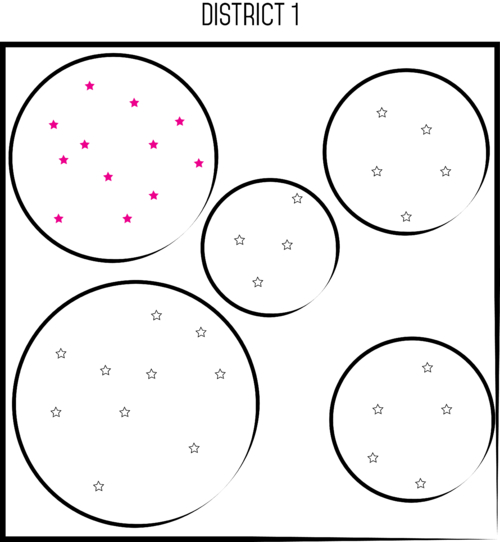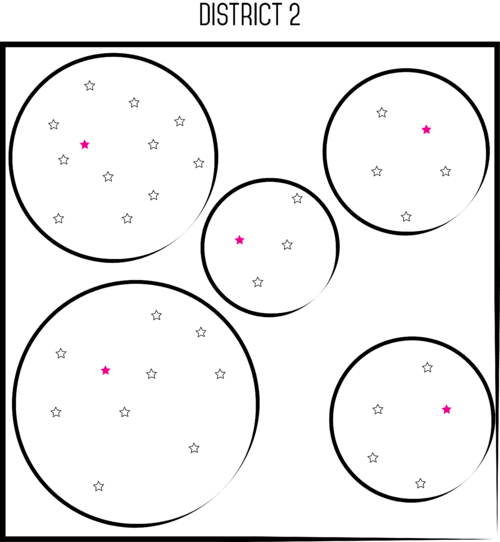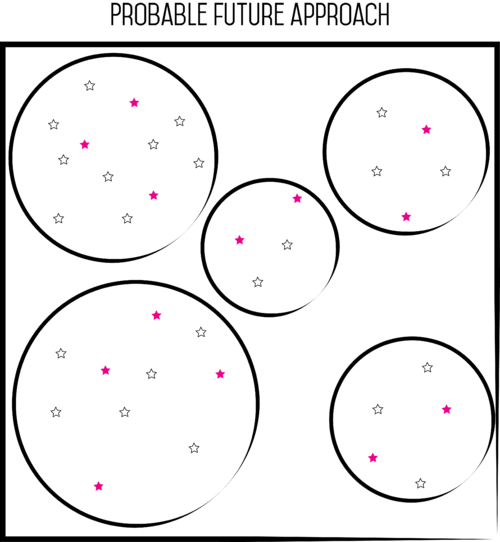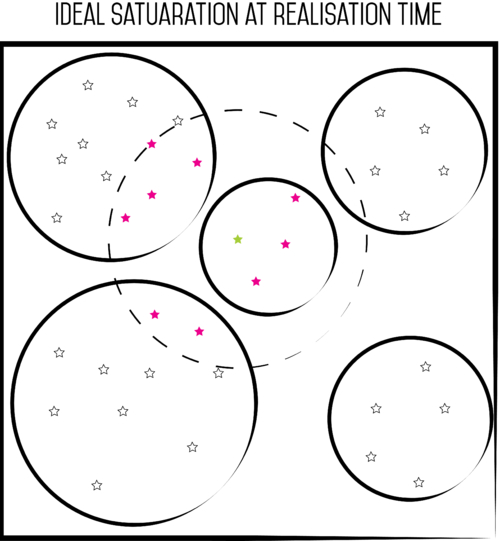Based on research and the valorisation of the gathered information, a pilot is designed. While designing, the different stakeholders of the cocoa chain are taken into account and how they could fit within the pilot. Cocobod or an LBC could be an option, Farmerline already has experience in doing business with them and how to do business with them. At the moment, there are very few cocoa farmers directly subscribed to the services of Farmerline. Therefore, there was concluded that the cocoa farmers are a potential target group to test a pilot. Also, many cocoa farmers do not know that Farmerline even exists. If they are not aware of Farmerline, they also do not know which opportunities they are missing. The minor group came up with an idea where cocoa farmers start using the voice message services and are motivated to spread the word. This pilot is to test the efficacy of a referral system, and which approach works best to grow paying cocoa farmers to Farmerline.
Setup
During the three-month stay in Ghana, there were several meetings held with Adwumapa, which is an LBC. Adwumapa invited the minor group and Farmerline to meet the cocoa farmers together. They explained a lot about their business and they are starting to get in business with Farmerline. Adwumapa realised that investing in their cocoa farmers is important. Therefore, this pilot is an excellent tool to start the relationship with Adwumapa.
The pilot consists of two different setups. There are two pilot groups of cocoa farmers. One group lives in district 1, the other in district 2. In both districts live several communities. To be able to compare the results, there are a few difference between the two districts. The two groups are picked in collaboration with Adwumapa. The two districts should be similar in cocoa farmer density, as well as the the size communities.
In district 1, there will be one community where all cocoa farmers in that community are consumers of Farmerline in the initial phase. The cocoa farmers from the other communities in district 1 are not yet a customer of Farmerline.
In district 2, one farmer of every community will be a customer of Farmerline in the initial phase. All the other farmers of those communities are not yet a customer of Farmerline.
Show the initial phase of the pilot. Every star is a cocoa farmer who lives in a community – circle. The pink stars represent the cocoa farmers who are using the services of Farmerline. The open stars are cocoa farmers that are not yet a customer of Farmerline.
Referral system
The system works as follows:
Every cocoa farmer who is a customer (pink star) at the beginning of the pilot will get a three-month free trial of the voice message service from Farmerline. When the free trial expires, the cocoa farmer runs out of credits and should pay X dollars for new ones.
However, for every new referral the cocoa farmer acquires (open star), he will get Y credits. This means that the cocoa farmer is encouraged to help other cocoa farmers subscribe to Farmerline. The new customer that has been brought in by a cocoa farmer receives the same offer as the cocoa farmers in the initial phase. The new consumer applies for a three-month free trial and the option to acquire new customers.
Goal
In district 1, there is a lot of competition among the farmers to find new referrals. They need to reach out to other communities. In district 2, there is no competition in the communities at first. Our goal is to test which referral system has the quickest adoption of new paying cocoa farmers.
Two sub goals are to measure at which pace the network is expanding and to check how far the initial pilot reaches. These two aspects give an indication how long it takes to spread Farmerline’s services to all Ghanaian cocoa farmers and at how many places the pilot should be executed in order to cover all cocoa farmers within the set time limit.
Hypothesis
While district 1 is easier to set up than district 2, expectations are that the farmers find it harder to find new cocoa farmers from other communities. Concerns are that their range might not be large enough.
On the other hand, there is district 2, which needs more work to set up. However, because the range is smaller it is easier for farmers to find new referrals – they can find them in their own community – the feeling is that this system will have a higher adoption rate.
One variable is the degree of competition. At this moment it is unknown how a cocoa farmer reacts on competition in the same community. It could work as a boost. They accept the challenge and like to compete to each other. This is how district 1 operates.
Other concerns are that the range of a farmer highly influences the outcome of this pilot. There is a possibility that farmers like to refer to people they know and teach each other. If cocoa farmers find it hard to reach other farmers outside their own community, district 2 is a better option for them.
Purposes
Saturation time
One very important aspect is to calculate the saturation time of an area. The results of this pilot give the data to calculate this factor. Farmerline wants cocoa farmers to get used to the system, but eventually pay for it. When a cocoa farmer has been using the services of Farmerline long enough to decide that it wants to become a paying customer, his range should be fully saturated. If a farmer is able to keep referring to new farmers while he is already willing to pay for it instead, he shall choose the free option. At this point Farmerline loses money.
This means that the amount of credits (Y) that a cocoa farmer gets for a referral should depend on the potential new customers he could reach. The more potential customers in the cocoa farmer’s range, the less credit he gets for each referral.
Shows the reachable range of one particular cocoa farmer (green star) with the hyphenated circle. By the time the cocoa farmer has realised that paying for the services of Farmerline is worth it, all the cocoa farmers in his range should already been referred to. Either by himself or by other cocoa farmers.
This outcome of the pilot gives an indication of the reach and range of a cocoa farmer. This range can subsequently be used to calculate the saturation time of an area. Upcoming rollouts of Farmerline’s services can be done more precisely with this data.
Brand awareness
In meetings with different stakeholder in the cocoa industry, the minor group spoke about Farmerline. However, often they had never heard of the company before. The referral system is a great opportunity to increase the brand awareness of Farmerline among its potential customers. The big advantage of this system is that other people do the marketing for you, at a relatively very low cost. Also referred to as word-of-mouth advertising.
In-depth approach
The service
The services that are provided by Farmerline in the pilot phase are the same as after the pilot. There is always a chance the services will be optimised; this will always be in favour of the customer. The cocoa farmers get full on support at the start, just like they get when they go premium. When the farmer sees definite potential in the provided services, and when the range is saturated, this means that no more referrals can be delivered and the farmers become a paying customer. The premium service gives the cocoa farmers the same experience as during the referral phase.
How to refer
Every cocoa farmer who starts using the services of Farmerline gets a personal referral code and the phone number where referrals can be submitted. If a cocoa farmer convinces someone to subscribe, he shares his referral code with that person. This new member sends a message to Farmerline attached with the referral code, the language the cocoa farmer speaks and his location. Farmerline receives the referral code sent by the phone number of the new client and all the necessary information to send the new cocoa farmer the accurate voice messages. The new client also gets his own referral code to refer to new other cocoa farmers.
Risks and failures
A probable risk is that a cocoa farmer refers to a cell phone number of a non-farmer. The cocoa farmer could refer to his son to get free credits. To avoid this, Farmerline should do regular checking on the person who is referred to. Cocoa farmers could be warned beforehand to not do this or ‘sanctions’ will happen.
Cocoa farmers could change their phone number over time. They should be able to pass this information on to Farmerline.
There is a risk that Adwumapa is not willing to collaborate with Farmerline to set up this pilot. If this is the case, Farmerline should look to other businesses that have similar tools to execute and test this pilot. Other LBCs or farmer associations can be a great option.
The ideal situation is to have two districts of cocoa farmers where no one is a client of Farmerline, at the moment. This give the best test results, because in both cases the realisation time starts at zero at the beginning of the pilot.
However, there is a chance that these districts are not easily be found. Farmerline should then consider applying this pilot on an existing farmer group. The efficacy of a referral system in general is then still tested. A disadvantage is that the difference between the two setups cannot be measured anymore.
Probable outcome
This pilot is only to test the how big the range of a cocoa farmer is and how he deals with the degree of competition. The most likely outcome of the pilot is that a combination of both is the best way to start the initial phase in successive programs (see “Figure 50. Probable future approach” on page <?>). Some cocoa farmers with a shorter range are only able to refer to cocoa from their own community, while others have a wider network. The latter are able to spread the referral system to other areas, thus expanding the total range.
Conclusion
The referral system is a new approach to get more paying cocoa farmers to Farmerline. This pilot tests the efficacy of a referral system, the referral ranges of a cocoa farmer and his behaviour towards competition. These three aspects, give a great insight in the habits of a cocoa farmer. The most important question to be answered is: Does the referral system work? If the answer to this question is yes, the latter two aspects become very useful. The range of a cocoa farmer give a good estimate of how much referral credits should be given to match the realisation time with the saturation time. The urge to compete gives an indication which system is most useful to choose in the future; either the one used in district 1 or district 2.



